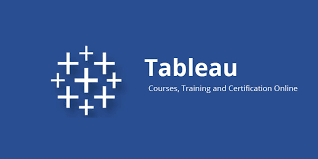
TABLEAU
Tableau: is a leading data visualization tool used for data analysis and business intelligence. Gartner’s Magic Quadrant classified Tableau as a leader for analytics and business intelligence. This Tableau tutorial will cover a wide range of how-to topics, including how to create different charts and graphs, in addition to visualizing data through reports and dashboards in Tableau to derive meaningful insights.
Tableau has a lot of uni
TABLEAU OVERVIEW:
Tableau offers five main products: Tableau Desktop, Tableau Server, Tableau Online, Tableau Reader and Tableau Public. Tableau Public and Tableau Reader are free to use, while both Tableau Server and Tableau Desktop come with a 14-day fully functional free trial period, after which the user must pay for the software.
Ecorp Training offers Tableau Online Training in VibrantITs IT Tranining and Placement Assistance with real-time experts. We do offer Fast-Track Tableau Training in VibrantITs IT Tranining and Placement Assistance and One-to-One Tableau Training. Our Tableau Course Content designed by experienced professionals. Our team of Tableau trainers offers Tableau in Classroom training, Tableau Online Training and Tableau Corporate Training services. we provide Tableau Training in USA, UK, Singapore, Japan, Europe, and your flexible timings.
Introduction and Overview:
Why Tableau? Why Visualization?
Level Setting – Terminology
Getting Started – creating some powerful visualizations quickly
The Tableau Product Line
Things you should know about Tableau
Getting Started
Connecting to Data and introduction to data source concepts
Working with data files versus database servers
Understanding the Tableau workspace
Dimensions and Measures
Using Show Me!
Tour of Shelves (How shelves and marks work)
Building Basic Views
Help Menu and Samples
Saving and Sharing your work
Concepts and Options when Connecting to Data
Joining multiple tables
Data Blending
Copy and Paste
Data Extracts
Custom SQL
Publishing and Re-using Data Connections
Understand how to deal with data changes in your data source such as field addition, deletion or name change
Re-using and sharing data connections – the concept of metadata
Working with multiple connections in the same workbook
Analysis
Creating Views Marks Size and Transparency
Highlighting Working with Dates Date aggregations and date parts
Discrete versus Continuous Dual Axis / Multiple Measures Combo Charts with different mark types Geographic Map
Page Trails
Heat Map
Density Chart
Scatter Plots
Pie Charts and Bar Charts
Small Multiples Working with aggregate versus disaggregate data
Analyzing
Sorting & Grouping
Aliases
Filtering and Quick Filters
Cross-Tabs (Pivot Tables)
Totals and Subtotals
Drilling and Drill Through
Aggregation and Disaggregation
Percent of Total
Working with Statistics and Trendlines
Getting Started with Calculated Fields
Working with String Functions
Basic Arithmetic Calculations
Date Math
Working with Totals
Custom Aggregations
Logic Statements
Formatting
Options in Formatting your Visualizations
Working with Labels and Annotations
Effective Use of Titles and Captions
Introduction to Visual Best Practices
Building Interactive Dashboards
Combining multiple visualizations into a dashboard
Making your worksheet interactive by using actions and filters
An Introduction to Best Practices in Visualization
Sharing Workbooks
Publish to Reader
Packaged Workbooks
Publish to Office
Publish to PDF
Publish to Tableau Server and Sharing over the Web
Enroll For Course Now